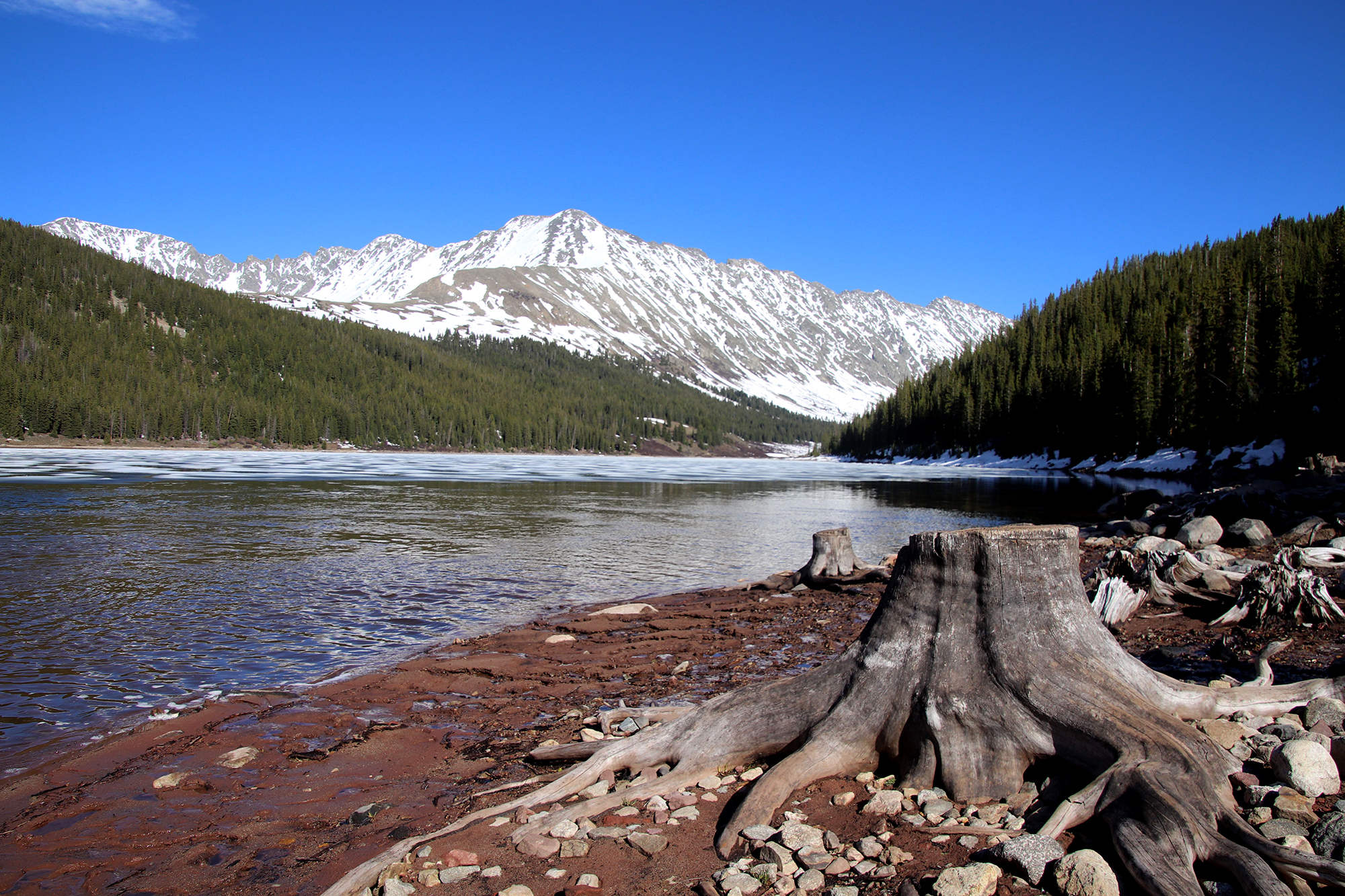 Everyone pees and poops—and that includes hikers, backpackers, climbers, trail runners, and paddlers miles away from a trailhead toilet or outhouse.
Everyone pees and poops—and that includes hikers, backpackers, climbers, trail runners, and paddlers miles away from a trailhead toilet or outhouse.
All that human waste can have serious environmental, health, and aesthetic impacts on the great outdoors though. So it's essential to be prepared to deal with it in different terrain and scenarios—deep in the woods, traversing snow above treeline, paddling down a river.
Whether you're enjoying your first hike or are a longtime Leave No Trace follower, you may wonder what exactly "dispose of waste properly" (Leave No Trace Principle #3) means in various situations. What needs to be packed out and what can be left behind? Where and how deep should that cathole be dug? What about if you have your period? And what is a WAG/waste bag or a poop tube anyway?
For all of us who head outdoors, and away from indoor plumbing, here are the guidelines for taking care of personal waste responsibly and reducing our impact on the lands and waters we love.
The Importance of Poop Protocol
First, you may be wondering if a little pee or poop in the woods really matters? Yes, particularly number two.
“Human waste and what we do with it can be one of the most significant impacts that faces lands used by the public for recreation,” said Ben Lawhon, director of education and research for the Leave No Trace Center for Outdoor Ethics. “It's a disease impact, water quality impact, social and aesthetic impact—and it's something that a lot of people just have a hard time dealing with.”
And when more people head outdoors, those impacts increase significantly.
According to The Outdoor Foundation's Outdoor Recreation Participation Report, more than 10 million people go backpacking every year and nearly 50 million take a day hike. While many hikers may be a short stroll from a bathroom, some undoubtedly find themselves out of range when nature calls. Plus, those millions of backpackers can be miles or days away from a toilet.
Then there are the millions of individuals annually who climb outside (10 million), canoe (9 million), run trails, ski, snowshoe, and occasionally need to make a pit stop.
In short: that's a lot of people outdoors, and thus a lot of poop.
And it adds up to a big impact.
Disease and Environmental Impacts
Feces contain a cocktail of germs, and no one enjoying the backcountry wants to see it, smell it, come in contact with it, or worse, get sick due to its improper disposal. Poop too close to water and you can pollute the water supply.
“Different water-born illnesses are correlated to human use of a given area,” said Jason Martin, executive director of the American Alpine Institute climbing school and guide service and a Leave No Trace Master Educator Course Provider. “When that stuff gets in the water supply, obviously it becomes a problem.”
Take a casual slurp from a clear, gurgling mountain stream and you're inviting the Giardia lamblia parasite to take up residence in your small intestine. A main culprit in water-born illness, the parasite can live for months in chilly ponds or lakes. It gets there through animal or human feces deposited directly in or too close to water sources.
Giardia symptoms, which usually set in a week or two after infection, include diarrhea and abdominal cramps, gas, nausea, sometimes vomiting, and usually a low-grade fever. Cryptosporidiosis, another parasite that causes severe diarrhea, is also a concern, as is Hepatitis A. (To avoid these issues, check out water treatment options for filters, purifiers, and chemical treatments.)
Aesthetic Impacts
The aesthetic issue is obvious: no one wants to hike, run, or climb amid exposed human feces or tufts of soiled toilet paper floating merrily on the breeze.
According to Mike Smith, a forest planner with the U.S. Forest Service in Colorado's San Isabel National Forest, backcountry waste disposal is a problem many land managers share. High trail use, hikers' improper disposal methods, no mandatory pack-it-out requirements, and a lack of funds to provide education, oversight, and supplies (like waste bags) make for unappealing encounters on the trail.
Trails in San Isabel's South Colony Lakes Basin, Smith said, see 50 to 100 people every day in the summer season, many of whom spend a night or two, and signs of that heavy use are apparent. “Walk 50 feet from any campsite and you're going to find little white toilet paper muffins scattered around,” Smith said. “There's only so many rocks and trees.”
Proper disposal ensures others don't come across your waste (yuck) and also speeds up the decomposition process.
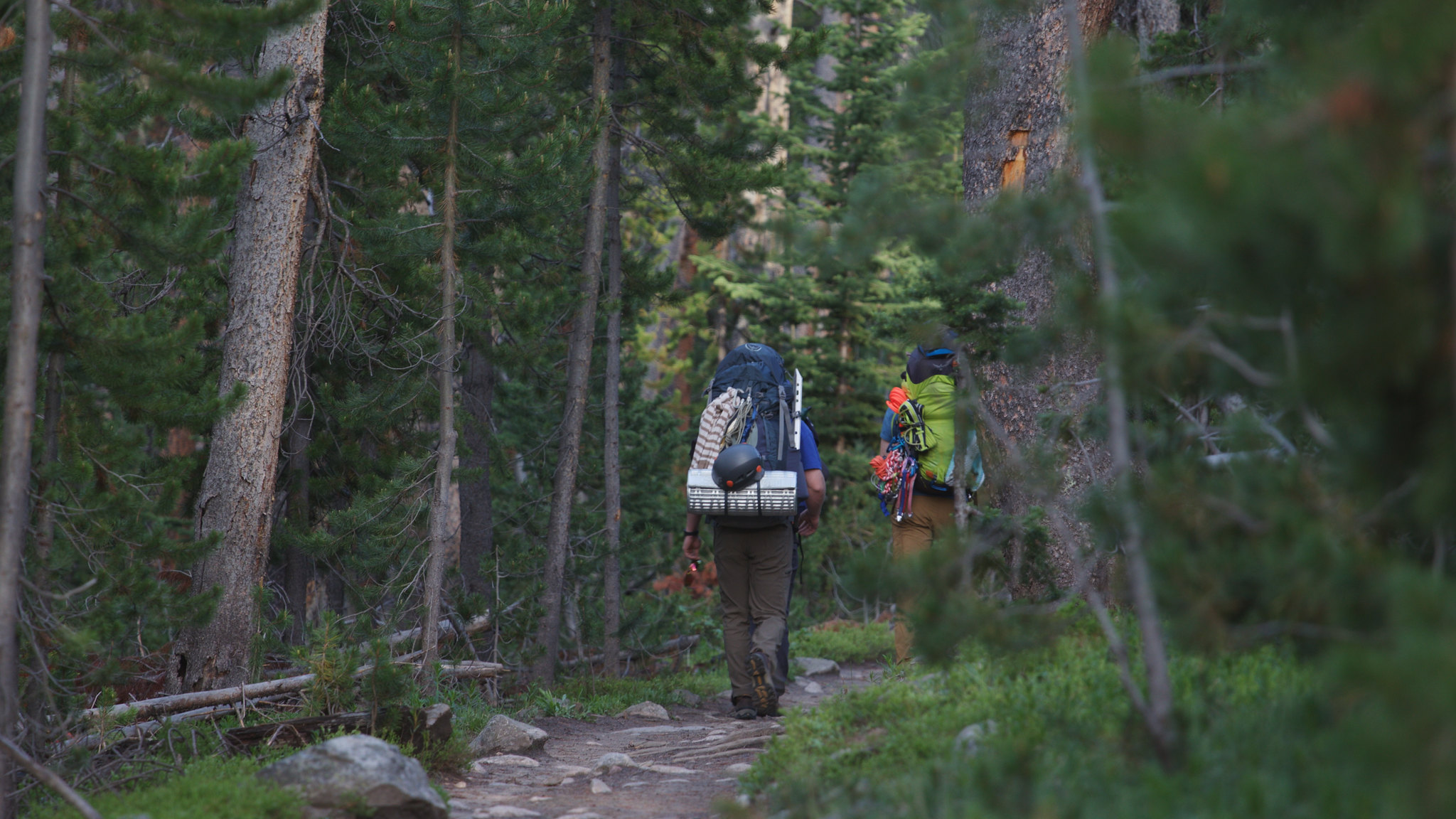
(US Forest Service photo by Pattiz Brothers)
Land Use Regulations
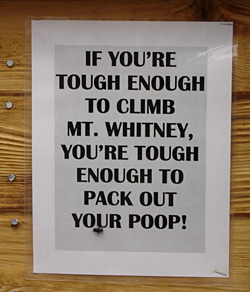
(Photo credit: Howard Kern)
Places without clear practices may struggle, but those that have implemented rules have seen success. Nick Meyers, U.S. Forest Service Lead Climbing Ranger on Mt. Shasta in California's Shasta-Trinity National Forest, said packing out waste became mandatory there in 1997. With such a well-established program in place, visitors are mostly used to the system in place now.
“We average about two and a half tons of human waste that's carried out by the climbers themselves," said Meyers. "Rangers pick up human feces all season long as sanitation is one of our top priorities in a few high use areas."
Knowing what regulations and methods exist, and which to practice where, can help wild areas, even well-traveled ones, remain as uncontaminated as possible.
While compliance is never 100 percent, Meyers thinks they do pretty well. "Over time, people have been getting used to our system. With thousands of climbers attempting the mountain each year, the fact that it has to be dealt with in the alpine environment is well-known."
In places where there aren't specific regulations or systems, Lawhon says Leave No Trace's goal is to provide a spectrum of approved options for waste disposal, and it's up to hikers and climbers to determine where on that spectrum they feel comfortable.
“We've tried to make it attainable for people to appropriately deal with waste in the backcountry,” he said. “If you say 'gotta pack it out, every time,' you just turn people off. The closer you get to the frontcountry, the more flexible you have to be. It's a continuum, and on one end you've got toilets at the trailhead, and on the other, you've got people packing out their waste.”
Now that we know why proper human waste disposal matters, here are the options for disposing of it outdoors.
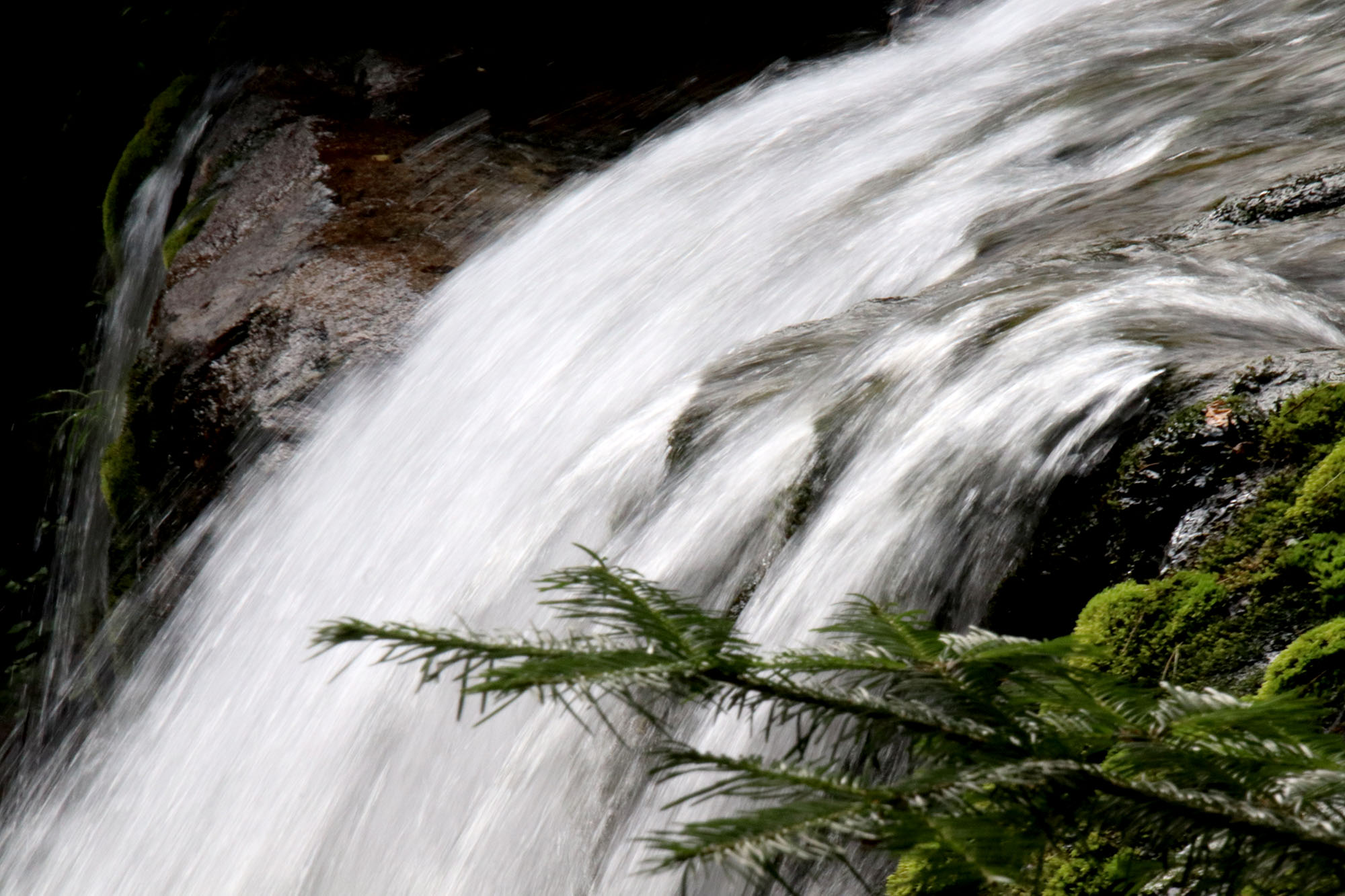
Number One, How to Pee Outdoors
Peeing outdoors is a relatively straightforward process, especially in comparison to solid human waste.
“What we advocate is to pee well away from water sources, trails, and campsites,” said Lawhon. “Based on World Health Organization and CDC [Center for Disease Control] research that has looked at urine, with most healthy people, urine is not a big deal. Unless it's highly concentrated, it's relatively harmless on the environment, so long as it’s kept out of any water source.”
- Walk 200 feet (that's about 70 steps) away from campsites, trails, and water.
- Find a secluded and appropriate spot, such as behind a tree, bushes, or large rock.
- Assume your position of choice—aim, squat, sit, stand.
- Avoid your boots and pants, and avoid peeing on plants that could be defoliated by animals attracted to the salt in urine.
- If you're on a slope, orient yourself so any runoff heads away from your feet.
- If water is plentiful, consider diluting the site with water to cut down on odor.
Do not pee directly into small ponds, lakes, or streams (see River Canyons below for the sole exception). Also, digging a hole or packing out urine isn't necessary, unless you're menstruating (see Menstruation below), in which case you should consider peeing into a cathole.
Pee Positions: Aim, Squat, Stand, Sit
What peeing position works best depends on your anatomy and personal preference. The main methods of urinating outdoors are standing and aiming, squatting down low, and sitting. People who need to squat or sit may want to practice several methods to find the best position for them and to avoid splatters.
Standing and Aiming
If you can naturally aim, follow the steps above and point at an appropriate spot that meets Leave No Trace guidelines.
How to Use a Pee Funnel
If you want to pee standing up without undressing, but can't aim your flow, consider a pee funnel. Referred to by a variety of names—stand to pee device (STP), urinary director, female urination device (FUD), feminine funnel, or pee funnel—a funnel can be useful when hiking, camping, climbing, traveling, for medical or mobility needs, and in areas with little privacy (such as high above treeline or stuck in a tent).
Examples include the GoGirl, pStyle, Freshette, Shewee, Tinkle Belle, and Whiz. Some funnels also come with a carrying case and an extension tube.
Follow the directions from each brand, but generally to use a stand to pee device:
- Practice at home, preferably in the shower, before hitting the trail. These devices can take some getting used to and can easily spill or leak if you haven't practiced.
- Outdoors, find an appropriate spot.
- Hold the funnel close to your body.
- Let go, and aim the flow away.
- Clean your pee funnel off with water (200 feet away from the source).
- Store the funnel in a sealable plastic bag or carrying case.
Squatting
Squatting is a super simple, often-used, and convenient method. It doesn't require any extra gear or much practice, though there is the risk of splattering.
- Find an appropriate spot. Soft ground will better absorb the flow versus splattering it.
- Drop your pants or shorts below your knees and out of the way.
- Squat low. Consider holding onto a tree for balance.
- Keep any downhill flow away from your feet.
Sitting
Sitting is a less common option, but Kathleen Meyer, outdoorswoman, former river guide, and author of How to Shit in the Woods: An environmentally sound approach to a lost art, offers this step-by-step guide on peeing while sitting and still keeping your pants clean:
- Find a secluded spot with two rocks and/or logs, where you can sit on one and prop your feet up on the other.
- Slide down your pants or shorts.
- Set yourself on the edge of one surface.
- Prop your feet on the other surface (you're essentially creating a wilderness potty chair).
- Eliminate.
How to Use a Pee Cloth
If you don't want to pack out used toilet paper but do want to remove dampness, consider a pee cloth. Also called a pee rag or peedanna, a pee cloth is a reusable piece of cloth to wipe with after urinating (and only after urinating). It can reduce waste and the risk of chafing.
You can make your own pee cloth rag out of a bandana or a small microfiber towel, such as an extra small Packtowl. Or you can buy a ready-made option like the Kula Cloth, which snaps closed, has a waterproof outer layer, and is antimicrobial thanks to a silver treatment. Other options include Animosa P* Off Cloths, Wander Wipes, and WeeRags.
Follow the directions of your product, but generally to use a pee cloth:
- Wipe with the absorbent side after peeing.
- Snap closed.
- Hang outside your pack and/or in the sun to dry.
- If camping overnight, stow it away with other smellables.
- On the trail, periodically rinse your rag with water (200 feet away from water sources) and, if needed, a little biodegradable soap.
- Back at home, wash it with your laundry.
Leave No Trace offers this video on how to use a pee rag:
Number Two, How to Poop Outdoors
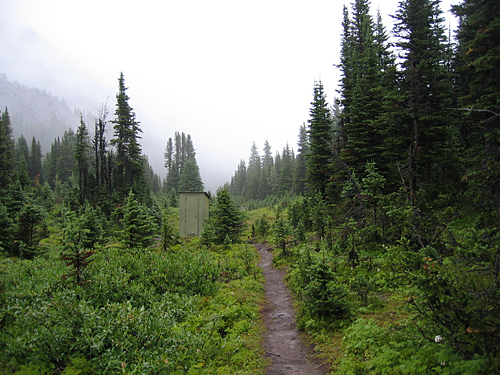
If a toilet is available, like this Canadian outhouse, use it. (Photo: Ben Lawhon)
Once you're out of range of that trailhead toilet, your options for dealing with number two are fairly simple: you can dig a hole and bury your solid waste, or you can pack it out. Those are the main methods Leave No Trace advocates, and those most widely used.
Two important things to know before heading out:
First, follow the area land manager's guidelines. If the Forest Service says thou shalt pack out waste, then arm thyself with a waste bag or other receptacle and follow the rules. “Talking to whatever land manager is in a given area is the most important thing of all. Find out what they feel is most appropriate. Don't assume,” said Martin.
Second, know and follow as many of the four objectives Leave No Trace outlines for backcountry waste disposal as possible:
- Minimize the chance of water pollution.
- Minimize the spread of disease.
- Minimize aesthetic impact.
- Maximize decomposition rate.
Digging and Burying: Catholes and Latrines
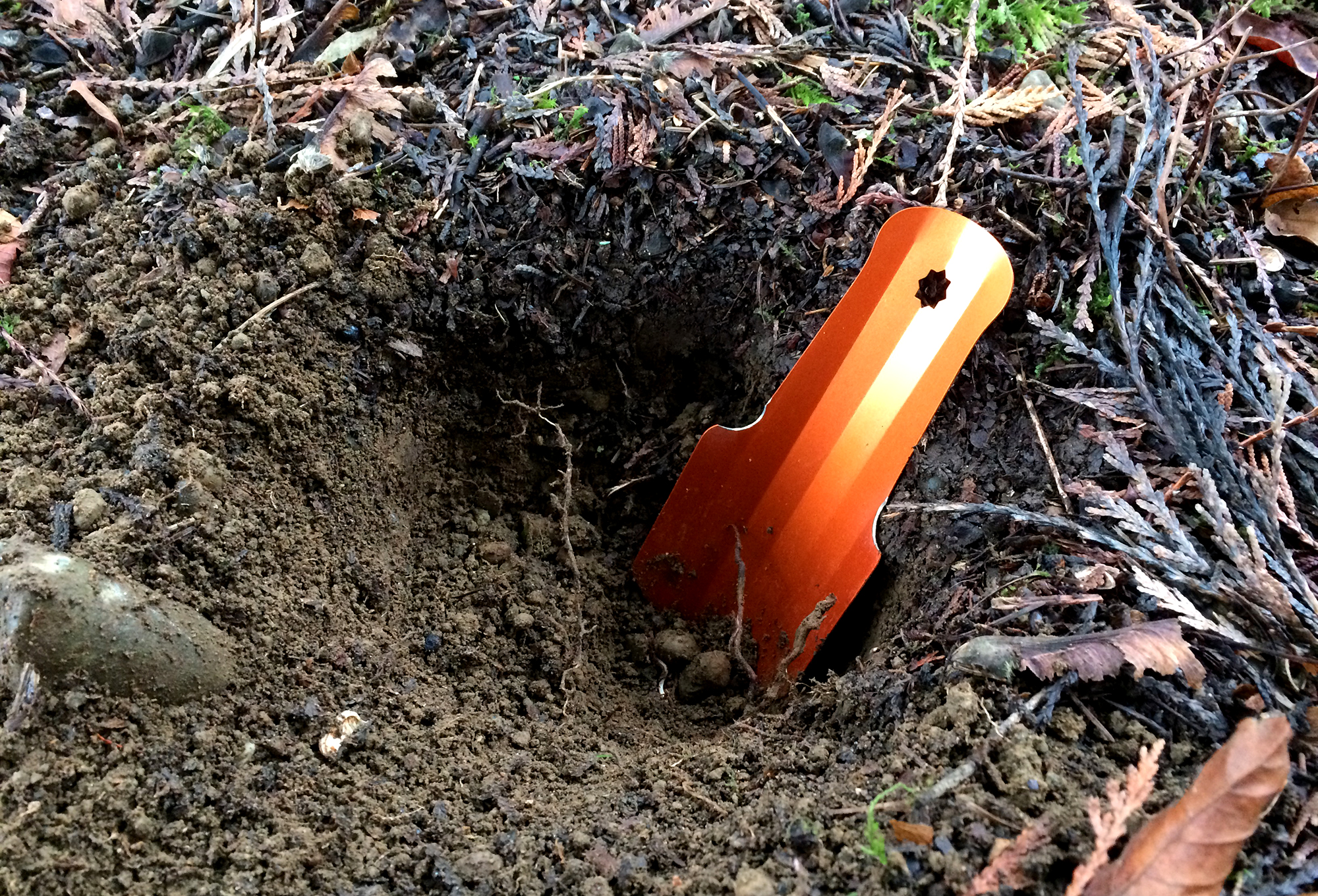
A trowel, like TheTentLab's Deuce of Spades, is essential to dig and bury. (Photo: Mike Mineart)
In places that don't have a specific pack-it-out rule, digging a cathole and burying feces is the most common backcountry waste disposal method. "It's our primary recommendation, if no toilet facilities are provided. We always default to a cathole for most terrestrial environments,” Lawhon said.
A properly sited and dug cathole has many advantages:
- Catholes are generally easy to dig and easy to disguise afterward.
- They're private, and it's easy to select a remote site other hikers won't encounter.
- They also disperse waste, enhancing decomposition.
Key to digging is finding a spot with organic soil and having a small, sturdy trowel. Even if you think you'll be near an actual toilet, there's always the chance you'll need to make an urgent stop on the trail, so make a trowel part of your essential gear. If you know the length of your trowel, you can use it as a measurement tool when digging. (Check out and compare camp trowels and shovels.)
How to dig a cathole:
- Find a site at least 200 feet (70 big steps) away from water, trails, and campsites, in organic soil to facilitate decomposition, and ideally near thick underbrush, decaying logs, or any places others aren't likely to encounter it.
- Did a hole six to eight inches deep and four to six inches wide.
- Squat over the hole and leave your deposit directly in it.
- Once you're done, fill in and cover the hole, disguising it with ground material.
- Do not touch the waste with your trowel.
- Scatter catholes if you're spending more than one night in an area, or if you're camping in a group.
- Avoid digging catholes in areas where the waste is unable to break down, such as arctic, desert, or alpine environments (see Unique Environments below).
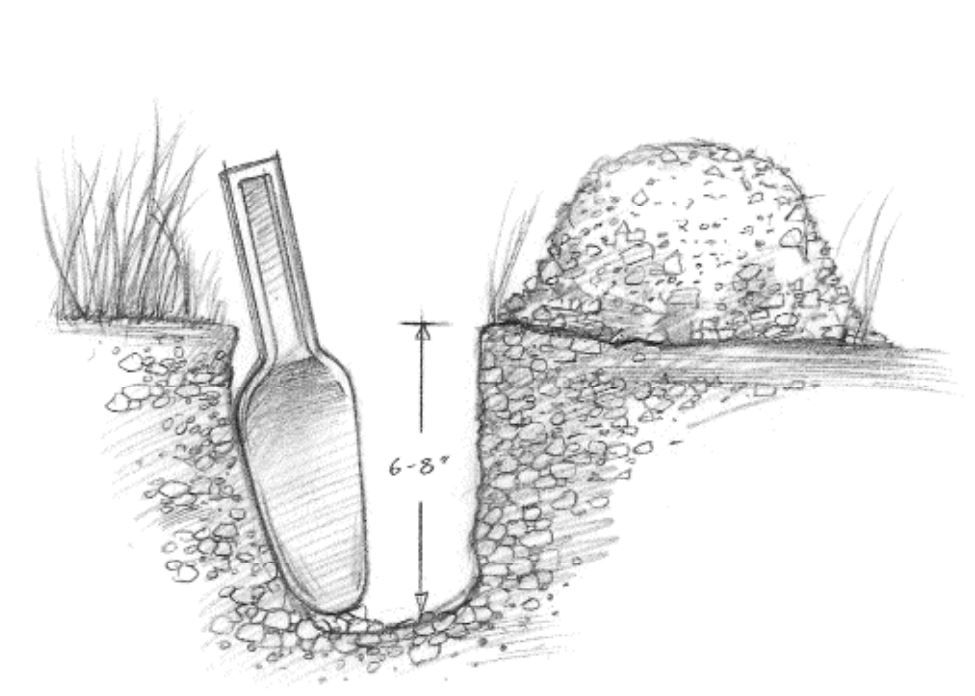
Dig catholes 6-8 inches deep and 200 feet from water, trails, and campsites. (© Leave No Trace Center for Outdoor Ethics)
Keep in mind that in shallow catholes, pathogens can remain a health hazard for a year, according to Leave No Trace: A Guide to the New Wilderness Etiquette by Annette McGivney. So, once you've found an appropriate spot, dig the full six to eight inches deep.
And once you're done, take a moment to make sure your cathole isn't visible. “Just because there's nobody there doesn't mean it's not heavily used,” said Martin. “If I'm going to use the bathroom in the woods, I don't want anyone to find it ever again.”
Leave No Trace offers this video on how to dig a cathole:
What about if you don't have time to dig a cathole?
Sometimes you have to go to the bathroom right now, and don’t have time to dig a cathole. What then? Easy—just poop on the ground, then dig the cathole next to it, use a stick to move the poop into the hole, cover, and disguise.
When and How to Dig a Latrine
Latrines are not commonly used, but you should opt for a designated latrine site “if you're going to be in a large group in one area for an extended period of time, or if you're going to be in a group of people you aren't certain can properly dig catholes,” Lawhon said, such as “kids or others who might not choose a good cathole site or dig correctly.”
A latrine is not the same as a pit toilet. Leave No Trace recommends a latrine be essentially a long cathole.
- Dig a trench that is 6 to 8 inches deep, 4 to 6 inches wide, and as long as needed for your group.
- Start at one end, and cover up as deposits are made.
- Follow the same requirements for site selection and depth as you do a single cathole site: a minimum of 200 feet away from water, trails, and campsites, in organic soil.
Because they have a greater concentration of waste-to-soil, the waste in latrines can take longer to decompose than in catholes, up to three years, according to Leave No Trace by McGivney. Therefore, latrines should only be used when necessary.
Leave No Trace offers this video on how to dig a latrine if you'll be in a large group:
What about toilet paper and wipes?
Aside from your number two deposit, the only other item allowed in your cathole or latrine is white, non-perfumed toilet paper, according to Leave No Trace. Personal wipes and sanitary products should always be packed out, since their materials decompose much slower.
However, many outdoors people have differing opinions on whether toilet paper is even appropriate to leave behind in the earth. Depending on the habitat and how fast buried waste breaks down, toilet paper can remain long after feces. Even in a proper cathole, it can take up to a year to break down, so leaving it should be a last resort. That said, if you do decide to bury your toilet paper, make sure to bury it deeply in the hole with a stick, which should be buried as well to minimize the potential spread of disease.
“The issue is that you're leaving something that shouldn't be left behind,” said Martin. “There's no reason not to carry it out. It's one small Ziploc, even for a big trip.”
Natural TP Options
If you don't want to pack out used toilet paper consider wiping with safe natural materials like fallen leaves (identify first!), packed snow, or smooth river rocks. You can bury the natural materials in your cathole with your waste.
- If you use toilet paper, pack it out whenever possible.
- If you're only peeing, consider wiping with a reusable pee cloth.
- If you must bury toilet paper, use as small an amount as possible and be sure to dig deep enough, at least 6 to 8 inches.
- Always pack out personal wipes and sanitary products.
"We prefer that all toilet paper be carried out, but we recognize that some people are uncomfortable with that," says Martin. "Toilet paper in a cathole will break down in a year or less depending on the environment...personal wipes, not-so-much. They take significantly more time to break down, and as such, should always be carried out."
Bottom line: no one wants to see a blooming bouquet of butt-wipe near the trail. The most astute hiker will pack out their toilet paper, in the interest of truly leaving as little trace of their presence as possible.
There is one definite toilet paper rule:
- Never burn toilet paper due to the risk of wildfires. Large fires have been inadvertently set by individuals who burned their toilet paper outdoors.
How to Pack Out Poop: Waste Bags and Poop Tubes
Many popular, high-use areas like Mount Rainier, Mount Shasta, Denali, and Mount Hood require you to pack out your waste. Some hikers pack out their poo even when they don't have to, in the interest of trying to make as little impact on the environment as possible.
Having the proper supplies—mainly a reliable, sanitary receptacle and hand sanitizer—is essential. You have several options, from store-bought waste bags approved for landfill disposal to homemade bags and containers, which can't be tossed in a landfill. (Note: even if you plan to dig and bury, it's a good practice to carry pack-it-out supplies anyway, for emergency circumstances.)
What's a Waste or WAG Bag?
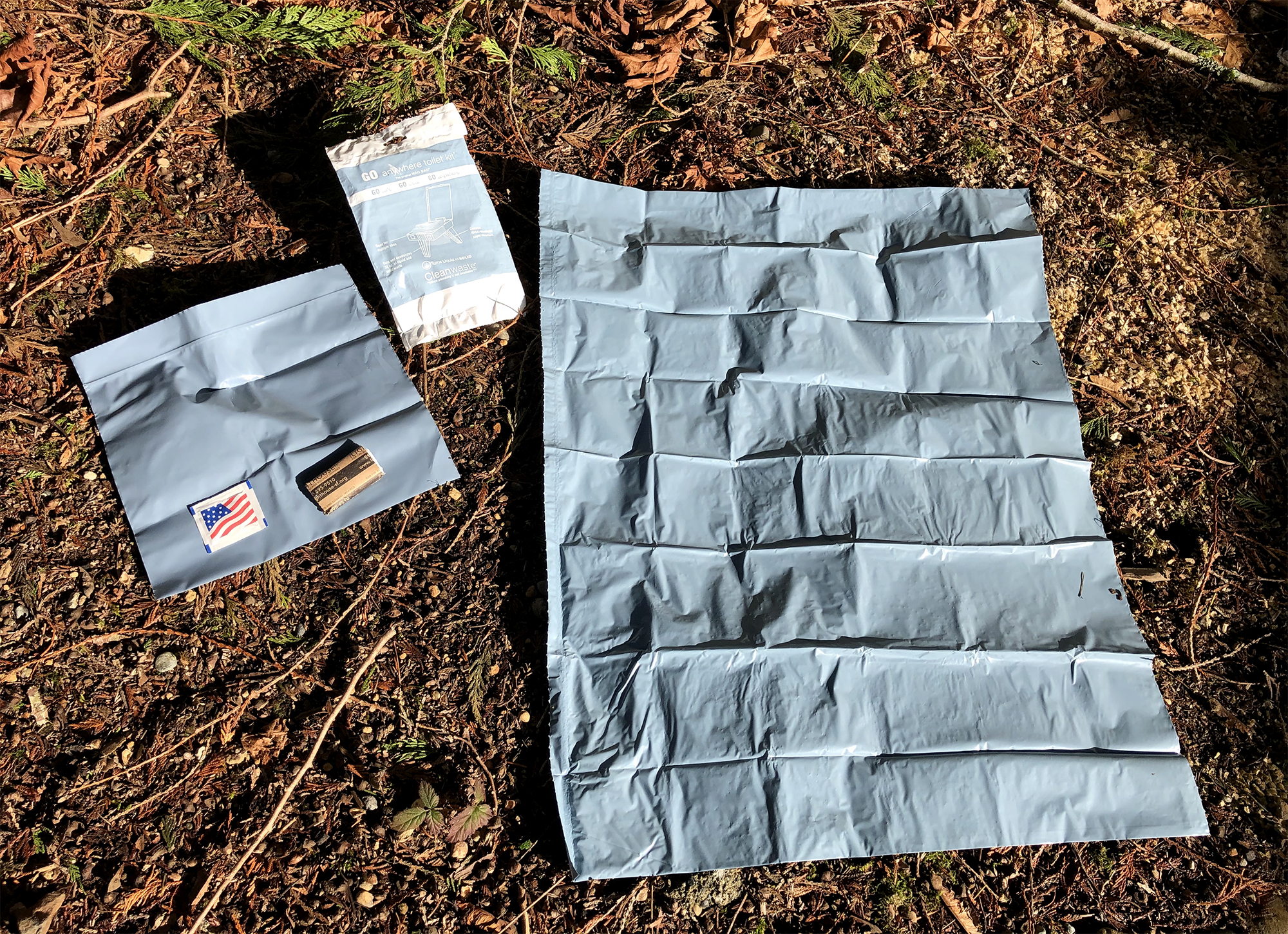
Cleanwaste Go Anywhere Toilet Kit Wag Bag (Photo: Mike Mineart)
You may have heard of a WAG (Waste Alleviation and Gelling) bag, but a better term might be "waste bag," since there are numerous commercial options for carrying out solid waste.
WAG Bags contain chemical crystals that gel human waste and render it inert, allowing you to properly dispose of it in a landfill or in a trash receptacle specifically for human waste. WAG Bags are necessary because only bagging waste creates a biohazard, which is illegal to throw out.
Pack-it-out bag systems generally utilize one bag you poop directly into and another sturdier, sealable bag in which you deposit and seal the dump. These also may be called a "blue bag system," and packing it out referred to as the “blue bag method,” because the bags provided to hikers at Mt. Rainier are blue, and Rainier has had a pack-it-out requirement for many years.
Cleanwaste, the company that coined “WAG Bag,” renamed its product the GO Anywhere Toilet Kit. The kit includes a biodegradable waste pickup bag loaded with Poo Powder, a “transport bag,” toilet paper, and hand sanitizer. The Poo Powder works by gelling more liquid waste, breaking down solids, and controlling odor. "I personally use the Cleanwaste bags whenever I have to pack out," said Lawhon of Leave No Trace.
Other waste bag options are Biffy Bags, which American Alpine Institute uses on its trips, and ReStop, which Leave No Trace offers in its online store.
Note that “blue bags” do not contain the chemicals that WAG bags do, and should only be used where recommended by a specific land manager, such as at Mt. Rainier.
Leave No Trace offers this video on how to use a waste bag:
How to Make a Homemade Waste Bag
You can create your own waste bag using an interior/pickup bag, pre-packed with Poo Powder or kitty litter, which functions similar to Poo Powder, and a larger, sturdy outer bag—think freezer-weight Ziploc. Heavy-duty trash compactor bags work as a waste trash bag. If bags don't seem sturdy enough, some people use a coffee can as their outer container. Tupperware with a snug-fitting lid that you're certain you no longer need in the kitchen would work, too.
Meyers, Lead Climbing Ranger on Mt. Shasta, says their rangers offer all hikers a user-friendly kit, assembled locally, which includes an 11 x 17 sheet of thick paper with a bullseye printed on it. To use—aim for the bullseye, do your duty, then grab the corners for pickup, avoiding all hand contact. Two brown bags with sawdust inside absorb moisture and a final ziplock bag allows for transportation down the mountain.
Meyers says the waste bags are available for free at all the Shasta trailheads, and hikers can pick up kits there or at area outdoor shops. "I'm approaching 20 years of working and using the waste bags on Mt. Shasta, and I give them my stamp of approval."
“Wagging” Tips
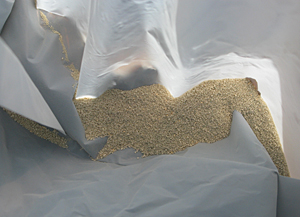
Powders, like Poo Powder above, or kitty litter solidify waste and control odors.
Best practices for using a waste bag come with, well, practice. Generally, when nature calls, grab your bag kit, toilet paper, bag for used toilet paper, and hand sanitizer and head off to find a secluded area where people are unlikely to encounter your bare bottom.
Put the bag on the ground, using a few small rocks to hold it in place (no one wants a poorly timed gust of wind to send the bag flying). Poop directly into the bag with the poop powder in it.
Fully enclose the poo and make sure the powder or litter has covered it. In other words, become familiar with touching your warm feces through a layer or two of plastic. Seal that bag inside the thicker, outer bag—getting as much air out of the bag as possible for easier storage—or stash it inside your container of choice. Place your used toilet paper in the bag. Clean your hands with hand sanitizer. Wag complete.
How to Make a Poop Tube
Poop tubes are more often used by climbers, but paddlers, hikers, and backpackers can use one too. You'll need a length of PVC pipe (around 4 inches in diameter), a cap for one end, and a threaded fitting and plug for the other. (For cleaning, it's helpful to be able to remove both ends.) What length you cut is dependent on the length of your trip and, frankly, how much you poop. Six to 10 inches is standard, though 12 to 25 inches is recommended for longer trips.
Either secure the tube to your pack with pack straps, or use duct tape and cord to make a handle and clip it to your pack for easy access. Pack standard coffee filters, place those on the ground, and aim. Or poop into brown paper bags. Wrap up the waste, send it down the tube, and seal it up.
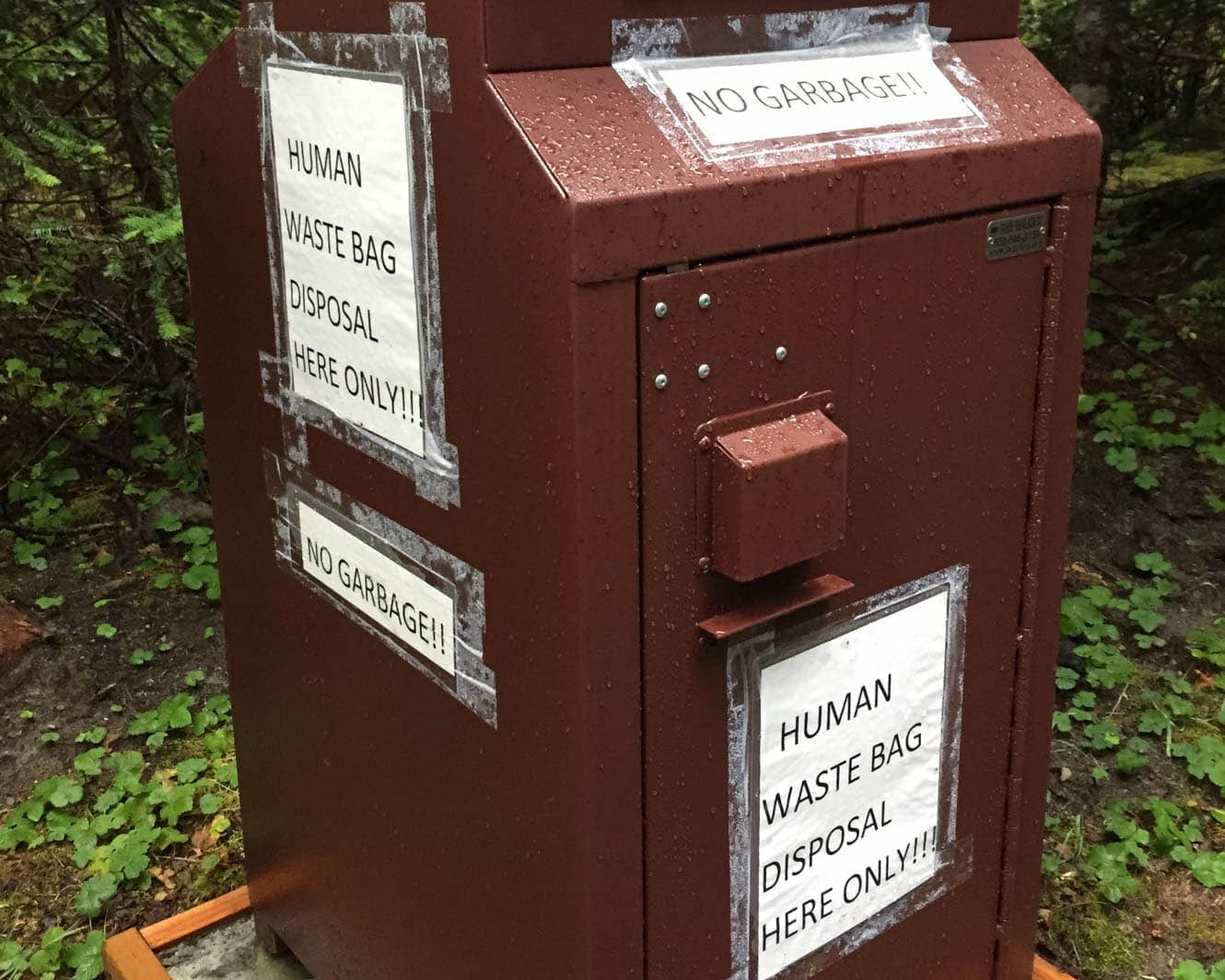 Dispose of waste in approved containers or toilets only. (Photo: Leave No Trace)
Dispose of waste in approved containers or toilets only. (Photo: Leave No Trace)
How to Dispose of your WAG Bag
Whether you pack it out in a bag, a tube, or Tupperware, waste must be properly disposed of after reaching the trailhead, often that means into your toilet. Always pack out your WAG Bags, and do not deposit them in pit toilets or compost, says LNT.
Users who make their own Wag Bags should note that homemade versions are not approved for landfill disposal and cannot be tossed that way. Commercially-available bags that have been approved for landfill disposal have been tested by the EPA, met standards for that disposal method, and state their approval. Check rules first.
How to Deal with Your Kid's Waste Outdoors
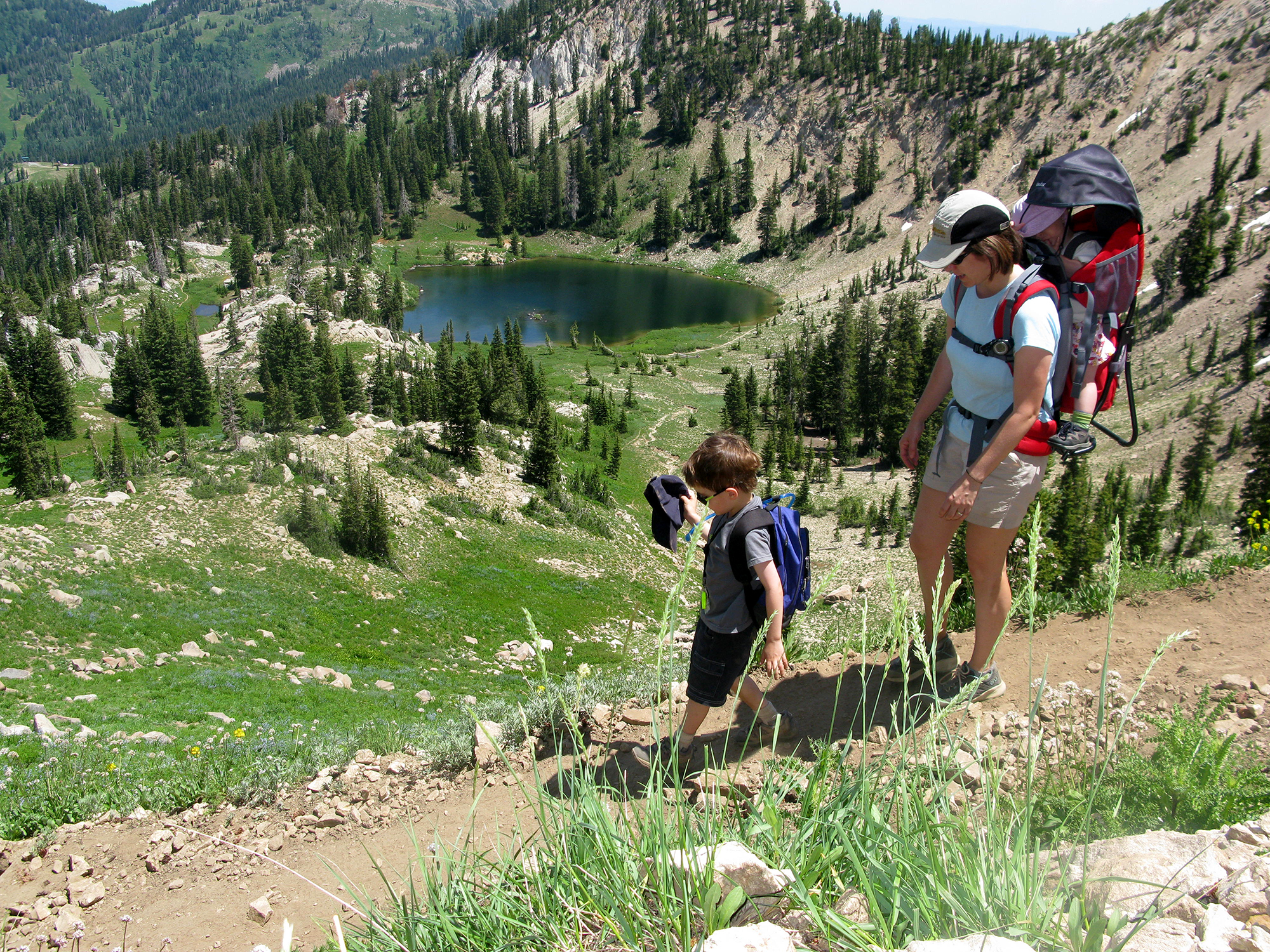
If your child is old enough to control when and where they pee or poop then follow the practices above. If they still wear a diaper or training pants, stick with the Leave No Trace advisement:
- Pack out all dirty diapers, as well as baby wipes.
Martin, a father of two, noted that the Australia-based gDiapers company offers diapers with inserts that supposedly biodegrade completely in a compost pile, but cautions that a six- or eight-inch cathole does not offer prime composting conditions.
Regardless of compostable and biodegradable claims, always pack out diapers and wipes.
Don't forget your Pet's Waste
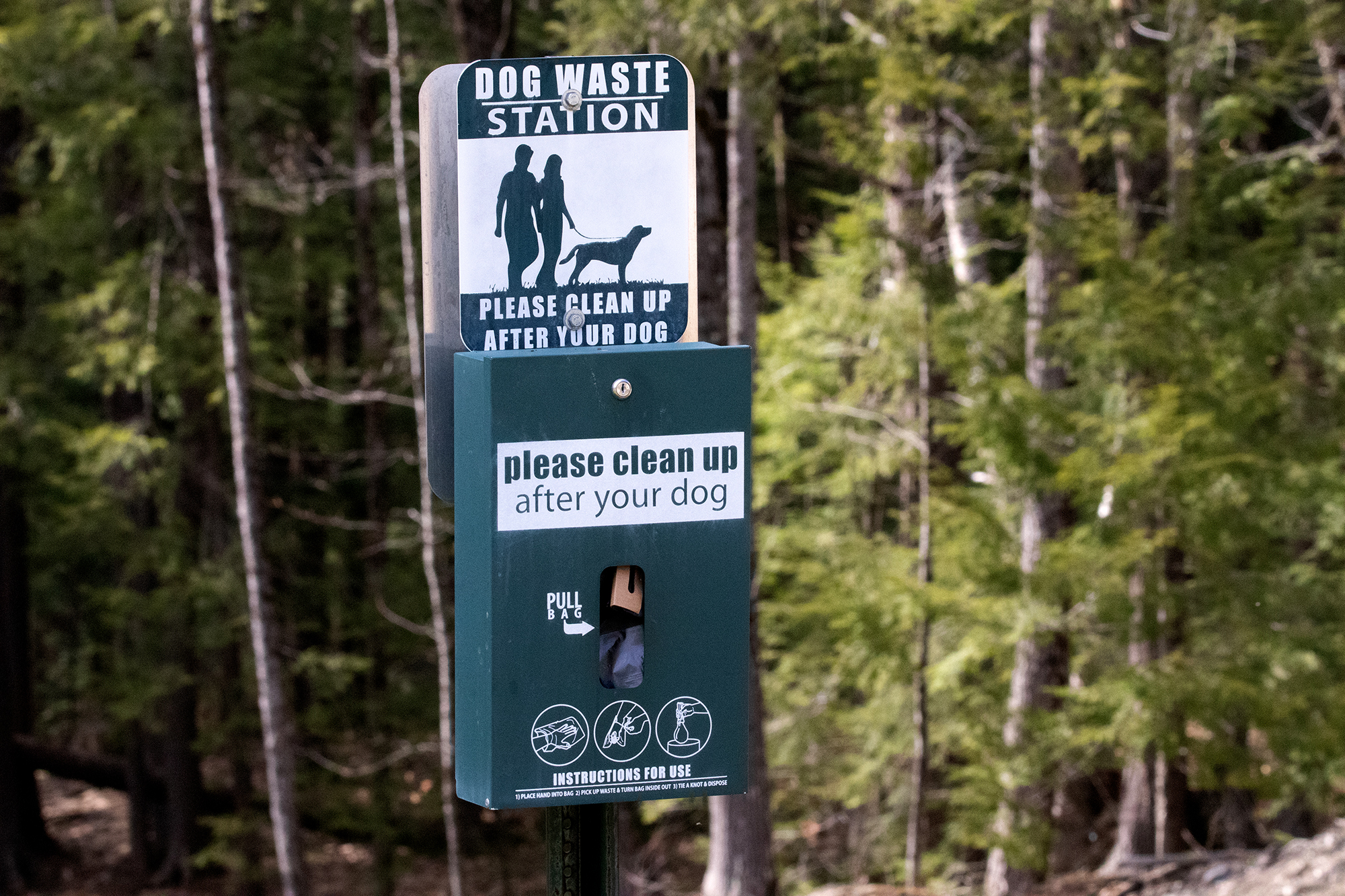
Your dog's pile of poo needs to be dealt with as well.
- In the frontcountry, pack out all pet waste.
- In the backcountry, treat it the same as human waste: either bury it or pack it out, depending on local guidelines.
"We encourage folks to consider packing out pet waste, even from the backcountry, but realize the practicalities and challenges of this recommendation," said Lawhon. "Therefore, we feel that catholing pet waste is perfectly acceptable."
Standard catholing guidelines should be followed.
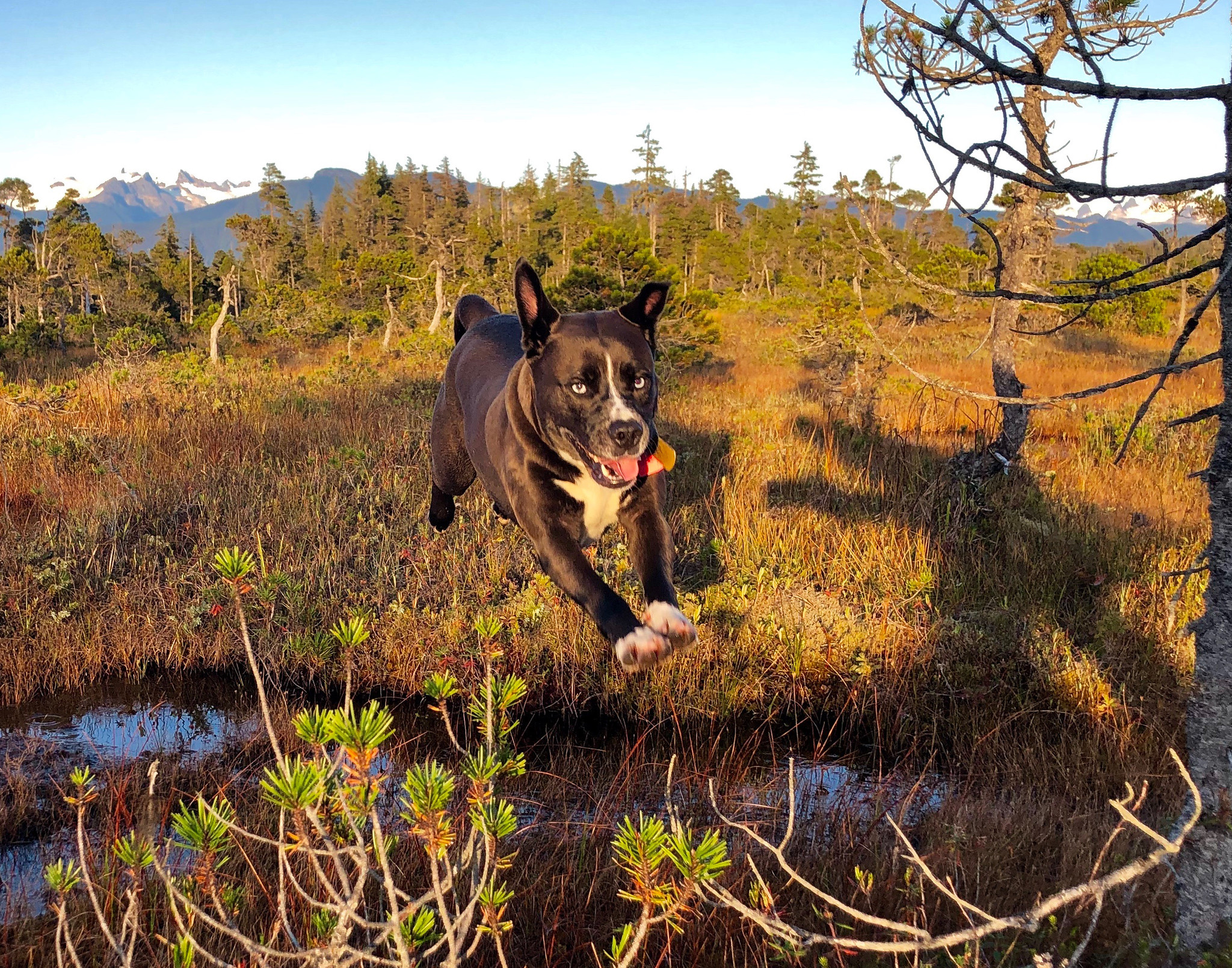
(Forest Service photo: Eric Castro)
Waste Disposal in Unique Environments
In desert, alpine, and arctic environments human waste breaks down very slowly, sometimes not at all. Even when buried the bacteria in feces can survive for years, so alternative disposal methods should be followed in these environments.
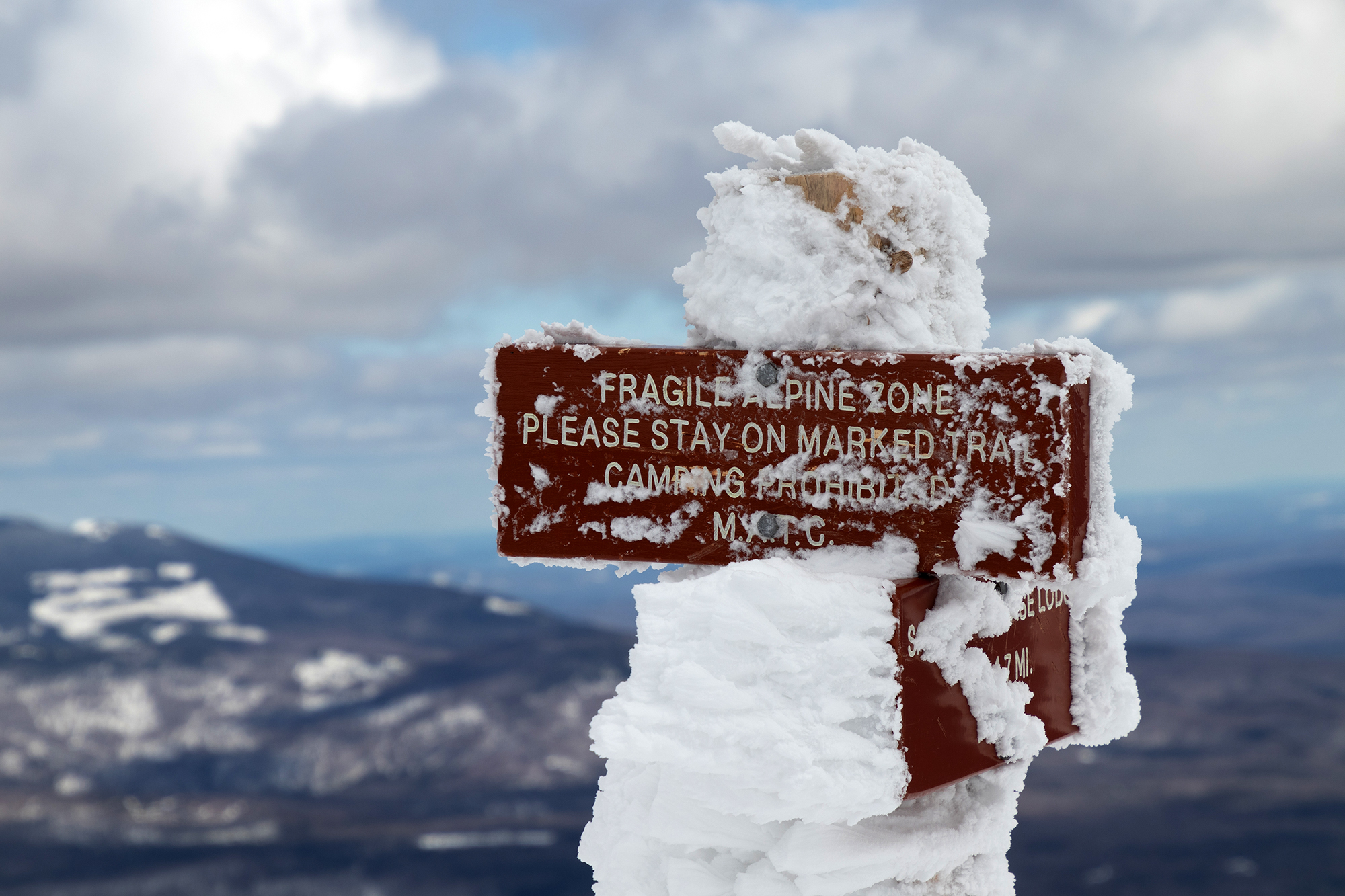
Above Tree Line
Alpine environments are far more delicate than the land below tree line. Again, Leave No Trace advocates for the pack-it-out method. Lawhon also recommends not making camp above tree line.
Digging a cathole up there is the last resort. “If you have to do it, move a big rock and dig under that large rock, rather than plunking your trowel down on delicate vegetation,” he said.
If you need to pee above tree line, urinate on rocks or bare ground, not on fragile plants.
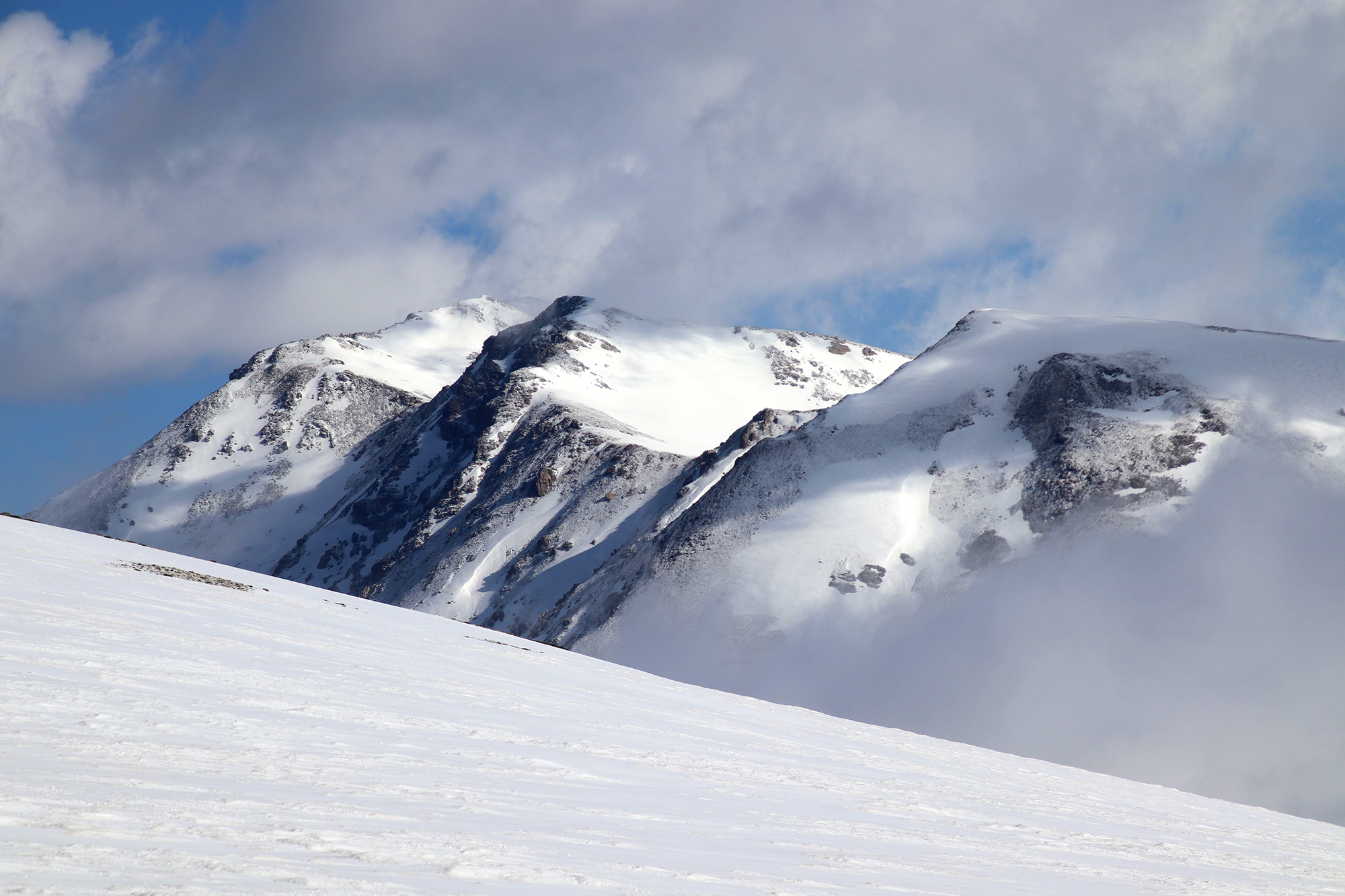
Above tree line and in winter, it's best to pack it out. Otherwise, you're leaving behind frozen waste for the next visitors.
Winter
Leave No Trace outlines three winter options for solid waste, in order of preference.
- First, pack it out. This is the preferred option, since poop can remain frozen in winter. It also means you won't have to deal with any odor.
- Second, attempt to find a snow-free area, like a tree-well, where you can actually dig.
- Third, dig a snow cathole.
“The key is, you've got to look at your map and make sure you're not dumping near a creek or other water source,” Lawhon said. And keep in mind that if you choose the third option, you're throwing the Leave No Trace human waste objectives three and four (aesthetics and decomposition) out the window.
Come spring, no one wants to find your semi-frozen waste on the trail. So, if you do choose a snow cathole, do it off travel ways and away from water sources. Choose a spot with sunshine, make a hole, cover your business, and let the snow melt dilute it. Snow works well as a T.P. alternative.
If you're on solid ice, packing it out is best.
As for peeing, cover any spots of yellow snow and pee away from water sources.
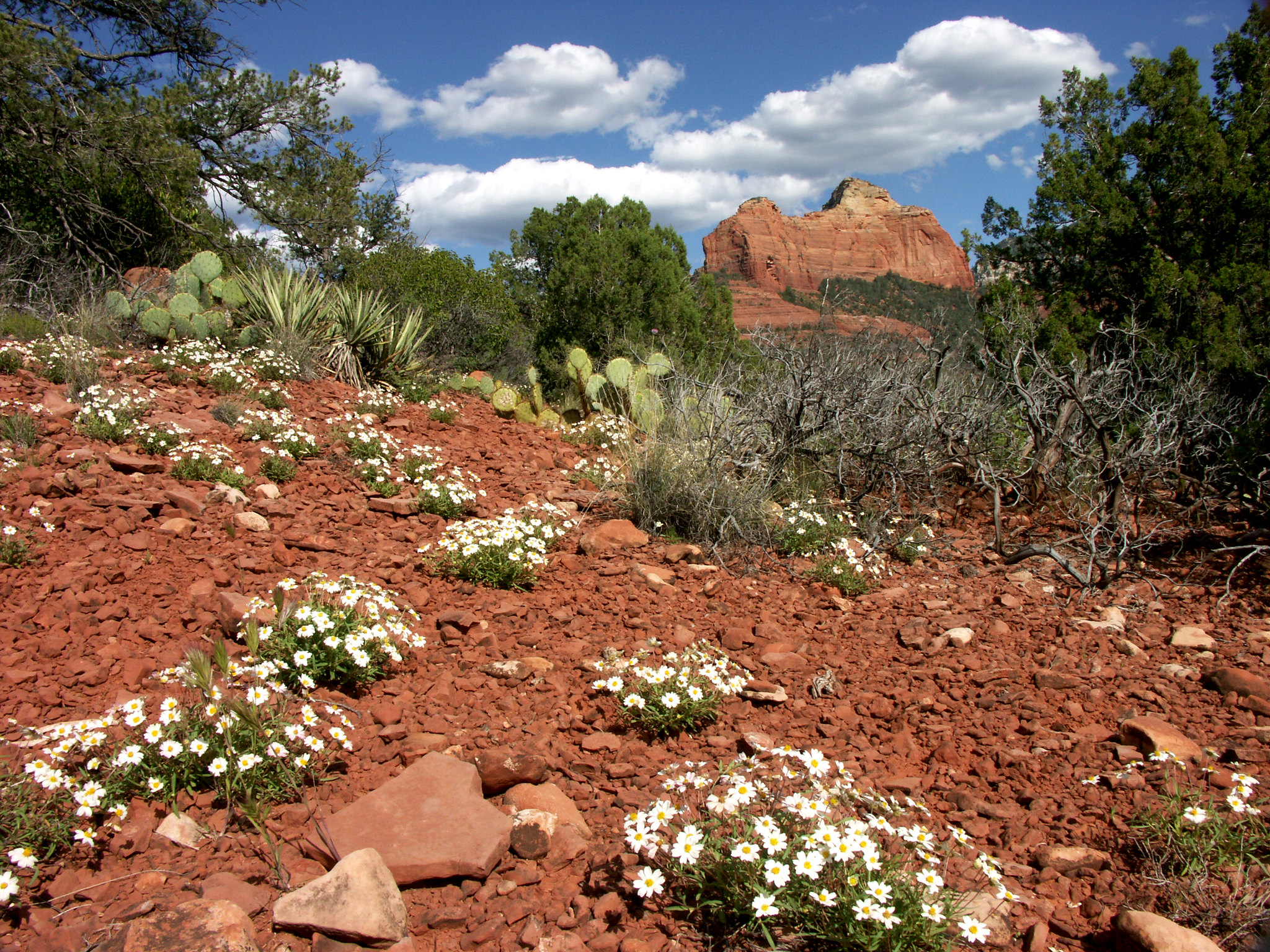 (Forest Service photo: Doug Madison)
(Forest Service photo: Doug Madison)
Desert
“We advocate shallower catholes, in the four- to six-inch range,” Lawhon said of desert terrain. Keeping the waste higher in the soil horizon maximizes decomposition.
Look for organic soil under trees and avoid living soil crusts (formerly known as “cryptobiotic soil crust”), which are extremely fragile and can take decades to recover if disturbed.
Remember to pack out all toilet paper whenever possible, as the desert environment isn't wet enough to facilitate decomposition.
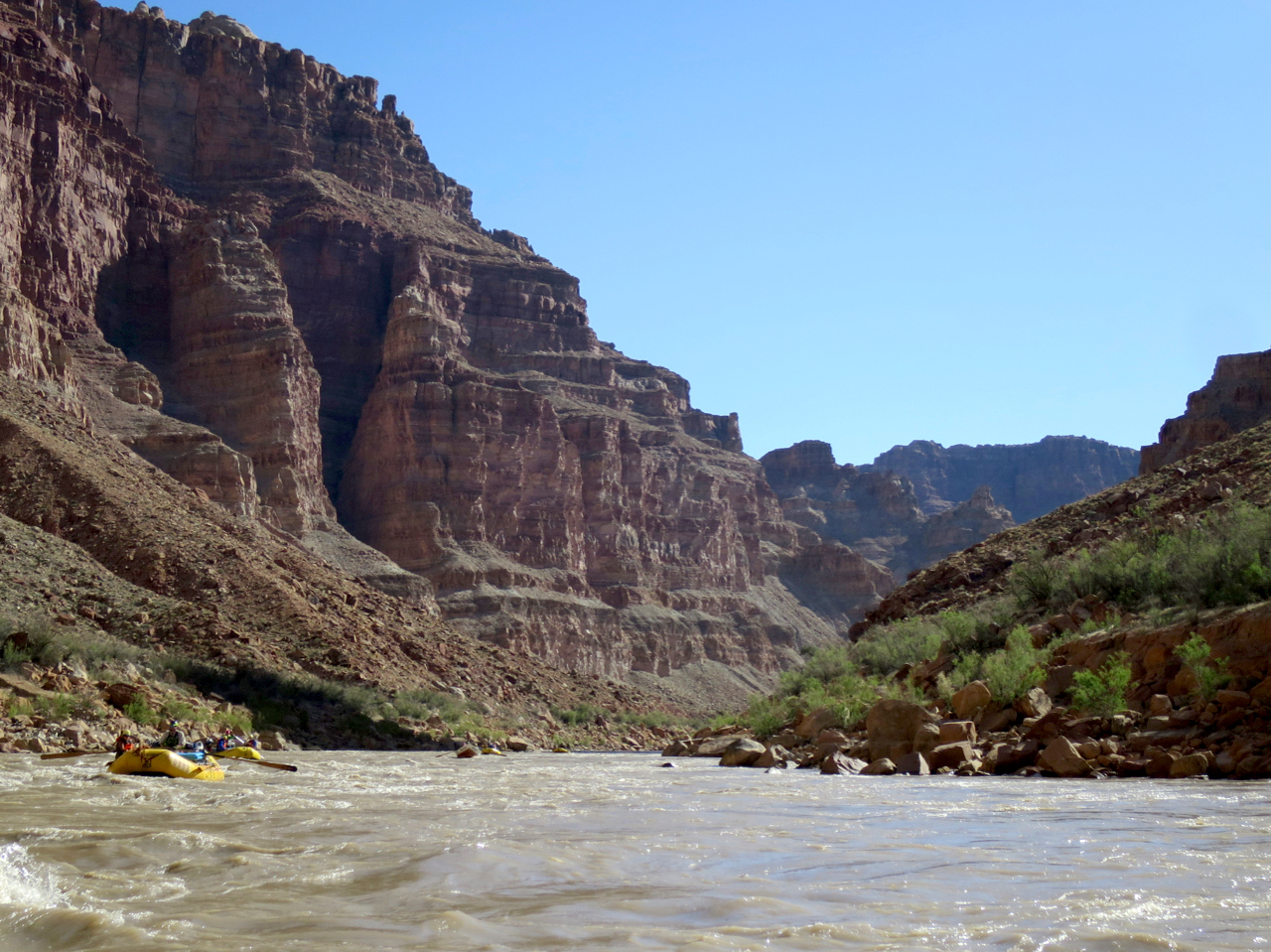
Running rivers, like the Colorado through Cataract Canyon, means knowing local land use regulations for human waste. (Photo: BigRed)
River Canyons
In river canyons where you may not be able to get 200 feet away from the water, Leave No Trace advises:
- Urinate directly in the river for dispersal ("dilution is the solution") where allowed.
- Not all rivers allow for the disposal of liquid waste into the river, so always check local rules and regulation.
- Pack out all feces.
“Packing out your poop is part of the river running culture, and I hope that becomes part of the culture in other user groups, too,” Lawhon said.
In many areas with low-volume rivers, it is illegal to urinate in the river, so follow the local guidelines. Generally speaking, flows of 1,000 cubic feet of water per second or greater are necessary to dilute liquid waste. In areas where you can't urinate in the river, it is recommended that liquid waste be dispersed away from camp and well above the high-water line.
Some paddlers and rafters carry a portable, reusable toilet system that they empty out later, or a poop tube. When he has the choice Lawhon prefers the Partner Steel Jonny Partner River Toilet. "I sometimes rent them for long raft trips" as it can handle six people on a 10-day trip. He most often uses the ECO-Safe Toilet System though, "because it’s much cheaper and more commonly used. Lots of our rafting crew have these tanks so it’s easy to round up enough for a trip."
Tent Bound
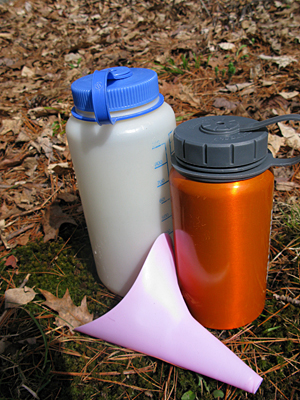
An old, well-labeled water bottle can serve as a pee bottle or emergency poop tube. A pee funnel, like the GoGirl, can help with aim.
If you find yourself confined to your tent, you're going to need a receptacle, like your homemade poop tube or pack-it-out bag and container. An old water bottle also can serve as last resort (label well). When urinating, aim very carefully, with the bottle's opening as close to your body as possible; a pee funnel you've already practiced with at home can help ease the process.
For number two situations, if you have no poop tube, this is your opportunity to use that extra waste bag/pack-it-out kit you've surely remembered to pack. Since you're in your tent instead of on natural terrain, the method is a little different. You're going to have to slip the plastic bag over your hand and play catch, or use the coffee filter you've brought with your poop tube.
No kit? You can use your spare water bottle, hold it close and aim carefully, adding it to your pee, and then dig and bury when the opportunity presents itself—basically, make your water bottle a makeshift poop tube. An appealing thought? No. Necessary in emergencies? Perhaps.
Menstruation and Period Protocol
If you menstruate, you'll need to deal with tampons, pads, a menstrual cup, or some combination of period products while recreating outdoors. Even if you don't menstruate, if you lead or educate groups, consider carrying some extra period supplies for others. Additionally, address the topic beforehand and educate others on how to manage menstruation and carry out waste, so everyone in your group feels comfortable and prepared.
Tampons and Pads
Leave No Trace's guidelines are simple: Pack out all used tampons, pads, and applicators. Do not try to bury them. They will not readily decompose and animals may be attracted to them and dig them back up. Do not try to burn them. Most products contain some synthetic materials, and it would take a very, hot intense fire to burn them completely, not to mention the potentially toxic chemicals that are given off when burning such materials.
- Consider tampons with no applicators, for less waste to carry in and out.
- Pack out all waste in a resealable plastic bag.
- You can add tea bags to the waste bag to reduce odor.
- If camping overnight, stow waste away with other smellables.
- Do not bury.
- Do not burn.
Menstrual Cups
Menstrual cups are reusable, non-absorbent, pliable cups you insert that collect menstrual fluid. Cups, like DivaCup and The Keeper, are popular with some long-distance hikers and trail runners, and Lawhon says Leave No Trace receives many inquiries about their use.
“What we came up with was to cathole menstrual fluid, because it's a biohazard,” Lawhon said. “The same principles apply.”
- Practice inserting and using a menstrual cup at home during your period.
- Outdoors, dispose of menstrual fluid in a cathole (200 feet from water sources, campsites, and trails).
- Clean your menstrual cup with fresh (boiled) water (not in a river or lake and, as always, 200 feet from any water source) before reinserting.
Peeing with your Period
If you have your period you should pee into a cathole, for the same reasons you'll dispose of menstrual fluid in a cathole.
Period Supplies
There are numerous options for dealing with your period while hiking, backpacking, and recreating outdoors. Ideally you'll want to try any at home, before relying on them on a trip.
Period underwear, like Thinx, which absorbs menstrual fluid can be helpful as a backup and to reduce the amount of tampons, pads, and period product waste you carry. You can pack all of your menstrual supplies—tampons/pads/cup, hand sanitizer, wipes and/or toilet paper, and extra plastic baggies for waste—together for ease of use.
Leave No Trace offers this video on dealing with your period while camping:
Gear Up and Be Prepared
As with most outdoor skills, preparation and practice make it far easier to deal with personal waste, whether you're on a local trail or in the wilderness. That means having the right supplies in your bathroom kit:
- Trowel—While you can dig with a stick in a pinch, trowels are your best option for digging a catholes. The TentLab's titanium Deuce of Spades is a favorite for its light weight, and Coghlan's Backpackers Trowel is Lawhon's personal favorite. "It’s the right weight, length, and has nice sharp edges for cutting into the soil," he said.
- Toilet paper and/or personal wipes—pack these out in a separate ziplock.
- Baggies—several sturdy, resealable bags for supplies and any waste you're packing out
- Hand sanitizer
- Pee funnel—If you want some assistance aiming your urine while standing fully clothed, try a stand to pee device. Practice at home first.
- Waste bags—for packing out solid waste
- Trash bag—A sturdy, sealable dry sack, like the Sea to Summit Trash Dry Sack, can securely hold a weekend's worth of waste.
Leave No Trace offers this video on building your own backcountry poop kit:
Finding Your Comfort Level
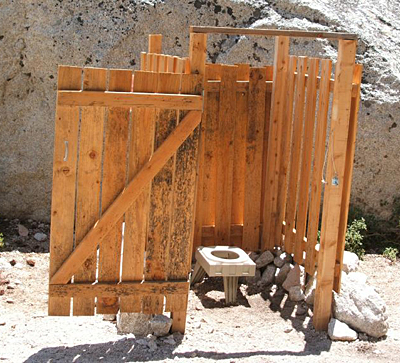
A toilet in California's Sierra Nevada. (Photo: Howard Kern)
When dealing with waste outdoors, it's important to follow local guidelines and remember Leave No Trace's overarching advice: find someplace along the continuum, in between trailhead toilets and poop tubes, where you feel comfortable.
If you're not willing to pack out your waste, some incredible outdoor spots will be off-limits to you. However, many others are easily within your reach, so long as you can dig an appropriate cathole.
Ultimately, respect the proper practices, check with area land managers before your trip, and do your part to keep the outdoors clean—even if it means having to pack up your own poo once in a while.
For more information
- Leave No Trace Center for Outdoor Ethics, Principle #3: Dispose of Waste Properly
- Recommend or review Waste and Sanitation Supplies and Devices and share your own backcountry sanitation tips with the Trailspace community.










